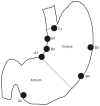Helicobacter pylori-negative gastritis: prevalence and risk factors
- PMID: 23147524
- PMCID: PMC3984401
- DOI: 10.1038/ajg.2012.372
Helicobacter pylori-negative gastritis: prevalence and risk factors
Abstract
Objectives: Recent studies using histology alone in select patients have suggested that Helicobacter pylori-negative gastritis may be common. The objective of this study was to investigate the prevalence of H. pylori among individuals with histologic gastritis.
Methods: Subjects between 40 and 80 years underwent elective esophagogastroduodenoscopy at a VA Medical Center. Gastric biopsies were mapped from seven prespecified sites (two antrum, four corpus, and one cardia) and graded by two gastrointestinal pathologists, using the Updated Sydney System. H. pylori-negative required four criteria: negative triple staining at all seven gastric sites, negative H. pylori culture, negative IgG H. pylori serology, and no previous treatment for H. pylori. Data regarding tobacco smoking, alcohol drinking, nonsteroidal anti-inflammatory drug, and proton pump inhibitor (PPI) use were obtained by questionnaire.
Results: Of the 491 individuals enrolled, 40.7% (200) had gastritis of at least grade 2 in at least one biopsy site or grade 1 in at least two sites. Forty-one (20.5%) had H. pylori-negative gastritis; most (30 or 73.2%) had chronic gastritis, five (12.2%) had active gastritis, and six (14.6%) had both. H. pylori-negative gastritis was approximately equally distributed in the antrum, corpus, and both antrum and corpus. Past and current PPI use was more frequent in H. pylori-negative vs. H. pylori-positive gastritis (68.2% and 53.8%; P=0.06).
Conclusions: We used multiple methods to define non-H. pylori gastritis and found it in 21% of patients with histologic gastritis. While PPI use is a potential risk factor, the cause or implications of this entity are not known.
Conflict of interest statement
Figures
Comment in
-
Editorial: no bugs bugging you? Emerging insights into Helicobacter-negative gastritis.Am J Gastroenterol. 2013 Jan;108(1):72-4. doi: 10.1038/ajg.2012.377. Am J Gastroenterol. 2013. PMID: 23287944
Similar articles
-
Gastric phenotype in children with Helicobacter pylori infection undergoing upper endoscopy.Scand J Gastroenterol. 2011 Mar;46(3):293-8. doi: 10.3109/00365521.2010.533383. Epub 2010 Nov 15. Scand J Gastroenterol. 2011. PMID: 21073375
-
Comparison of Helicobacter pylori infection and gastric mucosal histological features of gastric ulcer patients with chronic gastritis patients.World J Gastroenterol. 2005 Feb 21;11(7):976-81. doi: 10.3748/wjg.v11.i7.976. World J Gastroenterol. 2005. PMID: 15742399 Free PMC article.
-
High frequency of helicobacter negative gastritis in patients with Crohn's disease.Gut. 1996 Mar;38(3):379-83. doi: 10.1136/gut.38.3.379. Gut. 1996. PMID: 8675090 Free PMC article.
-
Helicobacter pylori: a cohort phenomenon.Am J Surg Pathol. 1995;19 Suppl 1:S30-6. Am J Surg Pathol. 1995. PMID: 7762737 Review.
-
Helicobacter pylori-negative gastritis: seek, yet ye shall not always find.Am J Surg Pathol. 2010 Aug;34(8):e25-34. doi: 10.1097/PAS.0b013e3181e51067. Am J Surg Pathol. 2010. PMID: 20631607 Review.
Cited by
-
Natural Progression of Helicobacter pylori-Negative Gastritis with Lymphoid Follicles in Children: Prospective Evaluation and Outcome.Turk J Gastroenterol. 2021 Jul;32(7):575-580. doi: 10.5152/tjg.2021.20595. Turk J Gastroenterol. 2021. PMID: 34464320 Free PMC article.
-
Analysis of risks of gastric cancer by gastric mucosa among Indonesian ethnic groups.PLoS One. 2019 May 9;14(5):e0216670. doi: 10.1371/journal.pone.0216670. eCollection 2019. PLoS One. 2019. PMID: 31071187 Free PMC article.
-
Antibiotic Resistance of Helicobacter pylori Among Male United States Veterans.Clin Gastroenterol Hepatol. 2015 Sep;13(9):1616-24. doi: 10.1016/j.cgh.2015.02.005. Epub 2015 Feb 11. Clin Gastroenterol Hepatol. 2015. PMID: 25681693 Free PMC article.
-
Helicobacter pylori and oral-gut microbiome: clinical implications.Infection. 2024 Apr;52(2):289-300. doi: 10.1007/s15010-023-02115-7. Epub 2023 Nov 2. Infection. 2024. PMID: 37917397 Free PMC article. Review.
-
Immunoglobulin gene repertoire diversification and selection in the stomach - from gastritis to gastric lymphomas.Front Immunol. 2014 Jun 3;5:264. doi: 10.3389/fimmu.2014.00264. eCollection 2014. Front Immunol. 2014. PMID: 24917868 Free PMC article.
References
-
- Sung JJ, Lin SR, Ching JY, et al. Atrophy and intestinal metaplasia one year after cure of H. pylori infection: a prospective, randomized study. Gastroenterol. 2000;119:7–14. - PubMed
-
- Haber MM, Hunt B, Freston JW, et al. Changes of gastric histology in patients with erosive oesophagitis receiving long-term lansoprazole maintenance therapy. Aliment Pharmacol Ther. 2010;32:83–96. - PubMed
-
- Peura DA, Haber MM, Hunt B, et al. Helicobacter pylori-negative gastritis in erosive esophagitis, nonerosive reflux disease or functional dyspepsia patients. J Clin Gastroenterol. 2010;44:180–5. - PubMed
-
- Merchant SH, VanderJagt T, Lathrop S, et al. Sporadic duodenal bulb gastrin-cell tumors: association with Helicobacter pylori gastritis and long-term use of proton pump inhibitors. Am J Surg Pathol. 2006;30:1581–7. - PubMed
Publication types
MeSH terms
Grants and funding
LinkOut - more resources
Full Text Sources
Other Literature Sources
Medical
Miscellaneous



